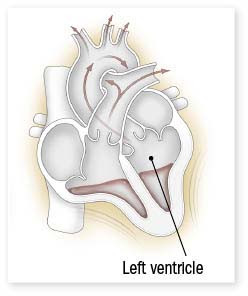Can I improve my ejection fraction?
Ask the doctor
 Q.
I'm a 69-year-old man. Seven years ago, I had a heart attack and received a stent. After some recent chest discomfort, I underwent a nuclear stress test, which fortunately showed no evidence of blockages. However, the report said that my ejection fraction was 49%, which I understand is just below what's considered normal. Is there anything I can do to increase my ejection fraction?
Q.
I'm a 69-year-old man. Seven years ago, I had a heart attack and received a stent. After some recent chest discomfort, I underwent a nuclear stress test, which fortunately showed no evidence of blockages. However, the report said that my ejection fraction was 49%, which I understand is just below what's considered normal. Is there anything I can do to increase my ejection fraction?
A. Ejection fraction is the fraction (expressed as a percentage) of the blood that your heart "ejects" out to the rest of your body each time it contracts. A healthy heart pumps out about half to two-thirds of the blood from its lower left chamber, the left ventricle. So a normal ejection fraction ranges from 50% to 70%.
An ejection fraction below 40% means the heart is struggling to provide sufficient blood to the body, which is known as heart failure. Values between 40% and 50% are considered borderline low and may be a sign of future heart failure risk. Because your ejection fraction falls just below what's considered normal, it might be a sign of a mild problem. However, a nuclear stress test has limited views, and there can be some variability in the results. Another option is to consider an echocardiogram (heart ultrasound), which is the standard test used to measure ejection fraction.
If the echo confirms that your ejection fraction is slightly lower than normal, your doctor will want to investigate the cause. The findings from your nuclear stress test rule out a blood flow problem, but there are several other possibilities. Causes of low ejection fraction include cardiomyopathy, a disease of the heart muscle with varied causes, such as a viral infection or a genetic disorder. Chronic high blood pressure can also decrease ejection fraction. So can the strain caused by a leaky or narrowed heart valve. An abnormally fast heart rate for a long period of time — such as from uncontrolled atrial fibrillation — can also weaken the heart.
If you're diagnosed with early heart failure, the good news is that exercise can help, including both aerobic exercise and strength training. Larger, more efficient muscles in the legs and arms can better extract oxygen from circulating blood, which appears to help compensate for the heart's decreased pumping power. If you're not already exercising regularly, however, be sure to check with your doctor first.
In addition, many medications, including beta blockers, ACE inhibitors, and angiotensin-receptor blockers, can improve or stabilize the ejection fraction. Increasingly, doctors strive to get all people who have heart failure with reduced ejection fraction (a common type of heart failure) on what's known as the "four pillars" of therapy, which consist of drugs in four different classes that help in different ways.
Illustration by Scott Leighton
About the Author

Christopher P. Cannon, MD, Editor in Chief, Harvard Heart Letter; Editorial Advisory Board Member, Harvard Health Publishing
Disclaimer:
As a service to our readers, Harvard Health Publishing provides access to our library of archived content. Please note the date of last review or update on all articles.
No content on this site, regardless of date, should ever be used as a substitute for direct medical advice from your doctor or other qualified clinician.
















